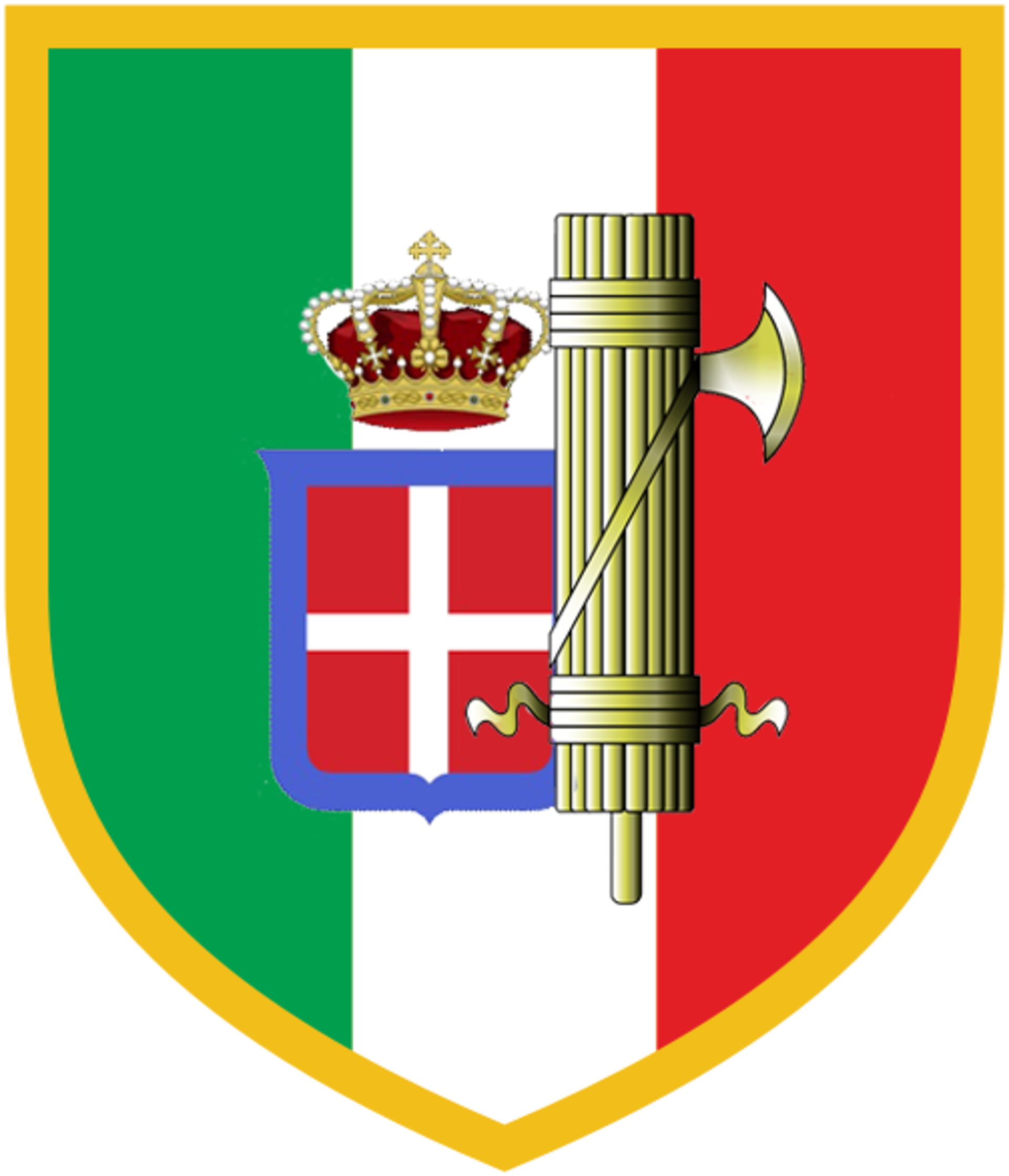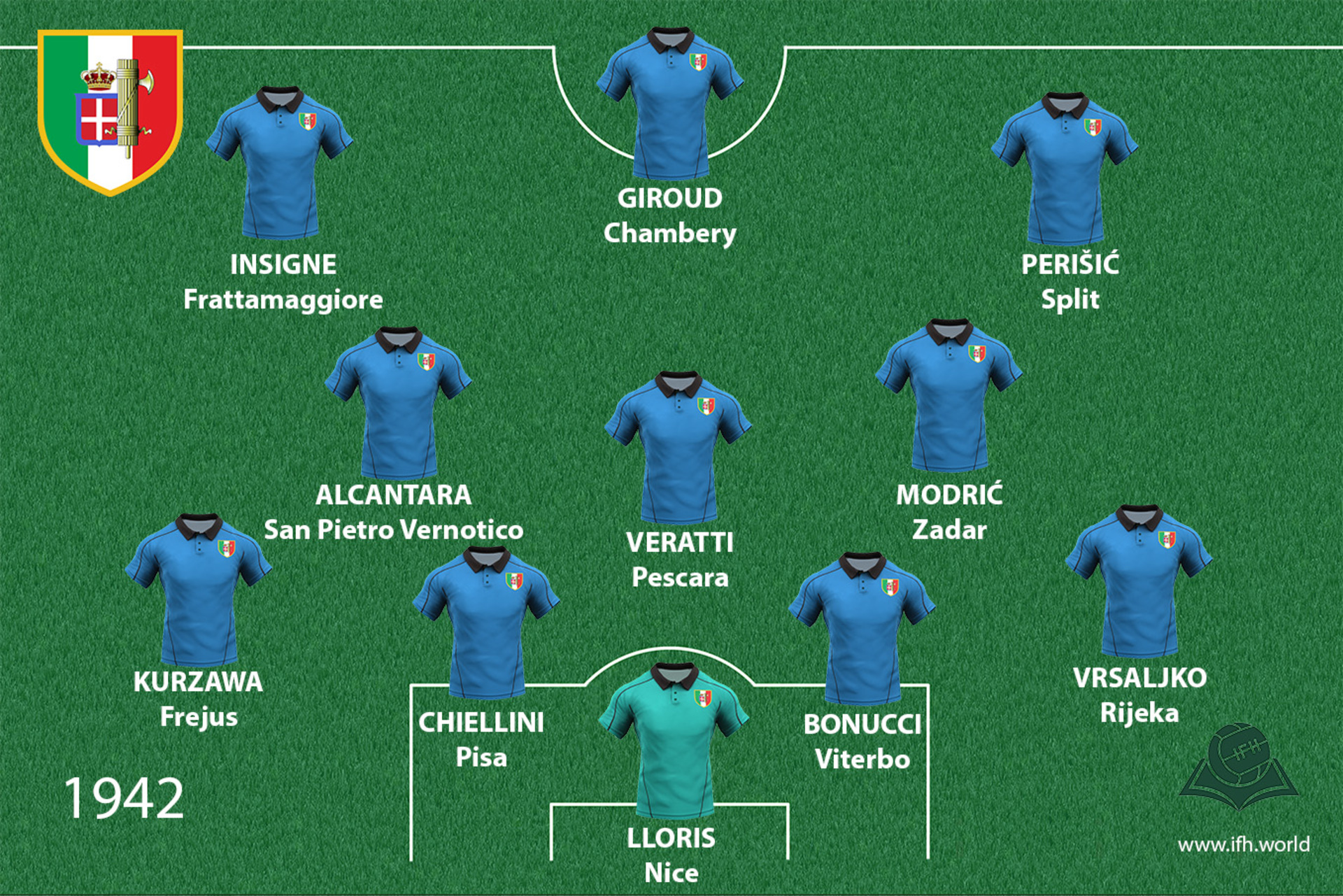Italy
Italy began to approach Nazi Germany only in 1936. If Italy entered World War I unprepared, it was even less so in WW II. Mussolini himself was aware of this, but he was convinced that the war was nearing its end, so he wanted to sit at the negotiating table on the side of the winner. Finally, he preached military values too long to stay on the sidelines and not be ridiculed for a seemingly easy victory.

Coat of arms
Shirt
| Position | First name | Last name | Mjesto rođenja | Like | Dislike | |
|---|---|---|---|---|---|---|
| GK | Gianluigi | DONNARUMMA | Castellammare di Stabia |
16 |
4 |
|
| GK | Hugo | LLORIS | Nice |
10 |
1 |
|
| DC | Giorgio | CHIELLINI | Pisa |
10 |
0 |
|
| DC | Leandro | BONUCCI | Viterbo |
12 |
3 |
|
| DC | Mattia | CALDARA | Bergamo |
2 |
2 |
|
| DRC | Daniele | RUGANI | Lucca |
4 |
2 |
|
| DLC | Alessio | ROMAGNOLI | Anzio |
5 |
1 |
|
| DRL | Matteo | DARMIAN | Legnano |
3 |
2 |
|
| DRL | Mattia | DE SCIGLIO | Milan |
4 |
0 |
|
| DRL | Šime | VRSALJKO | Rijeka |
54 |
7 |
|
| DL/ML | Layvin | KURZAWA | Fréjus |
8 |
3 |
|
| MC | Luka | MODRIĆ | Zadar |
90 |
8 |
|
| MC | Marco | VERATTI | Pescara |
7 |
0 |
|
| MC | Thiago | ALCANTARA | San Pietro Vernotico |
18 |
1 |
|
| ML/DL | Leonardo | SPINAZZOLA | Foligno |
1 |
1 |
|
| AMC | Nicolo | ZANIOLO | Massa |
2 |
0 |
|
| AMRL | Federico | CHIESA | Genoa |
2 |
0 |
|
| AMRL | Ivan | PERIŠIĆ | Split |
80 |
5 |
|
| AMRL/SS | Federico | BERNARDESCHI | Carrara |
7 |
1 |
|
| AMRL/SS | Lorenzo | INSIGNE | Naples |
10 |
3 |
|
| FRLC | Ante | REBIĆ | Split |
41 |
1 |
|
| FC | Andrea | BELOTTI | Calcinate |
5 |
3 |
|
| FC | Ciro | IMMOBILE | Torre Annunziata |
9 |
3 |
|
| FC | Mario | BALOTELLI | Palermo |
5 |
5 |
|
| FC | Olivier | GIROUD | Chambery |
4 |
0 |
(Today: Italy, coastal parts of Croatia, sout-eastern parts of France)
Just before the war, Italy occupied Albania that was friendly toward them, and was strategically important because of the control of the Strait of Otranto and as a staging ground for possible attacks on Yugoslavia or Greece. Italy also, thanks to German victories, occupied parts of southern France and annexed Nice, Ljubljana and Split.[1]
Some of the most prominent ideological characteristics of Italian fascism are the belief that the nation and its interests (determined by the Fascists) are above human rights and liberties, pronounced patriotism, and emphasizing national pride, i.e. the superiority of one’s own nation over all others.[2] It is also characterized by the blind celebration of “historical traditions”. To Fascists, it was equally important to create the illusion of continuity of political and cultural tradition. In order to do this, Mussolini decided to rely on the, never again reached and very much desired and dreamed, glory of the ancient Roman Empire and Caesar.[3] For this purpose, the Fascists revived the Roman greeting with the right hand raised at a 45 degree angle, Roman step, the symbol of a bundle of wooden rods with an axe in the middle (fasces), etc.
Fascism was not meant only for former soldiers, but to an entire class that felt their position in society being threatened and abhorred the breakdown of traditional establishments – religion and nation, that communism did not respect.[4] A large number of young people joined the Fascists since the post-war generation was, in its idealistic visions, disposed toward a movement that promised radical change in society.[5] Beauty of violence was one of the mobilizing passions of Fascism.[6] Fascism does not believe in the usefulness of lasting peace since it brings with it renunciation of combat and a fear of sacrificing; it lauds only war as the highest level of all human strength.[7] They held that encouraging war and violence was critical for attaining cohesion, discipline, and the explosive energy of fascism.[8] Fascist violence was directed selectively at “enemies of the nation” – socialists, Southern Slavs or African peoples who stood in the way of Italian hegemony on the Mediterranean.[9]
It would be erroneous to view Italian Fascism and German Nazism as synonymous, even though they did share certain characteristics such as belief in the superiority of one’s own nation, blind celebration of “historical traditions”, anti-communism, a single-party system, existence of parallel partisan and state institutions, homogenizing the nation through aggression, expansionist foreign policy, etc.[10] Still, a significant difference was in racism and antisemitism as central points of Nazism. Despite the campaign against Jews getting support from Mussolini, it was mostly condemned in Italy.[11] It bears mentioning that Fascist Italy, despite promoting the importance of strengthening the notion of race (la razza) in a cultural-historical sense, was not as affected by the northern European and American trend of biological purification of their own population (forced sterilization, medicinal euthanasia).[12] Likewise, there is a great difference in the leader himself, i.e. a greater attachment of Nazis to their Führer who, unlike the Duce, they never even considered deposing.
- [1] Giuliano PROCACCI, Povijest Talijana, Zagreb, 1996,312
- [2] Antun ROŠA, ''Između dva nacionalizma budi se treća strana - Ukrajinski anti-fašisti pozivaju na otpor protiv novih ekstremista i ostataka starog režima'' ,http://www.advance.hr/vijesti/izmedu-dva-nacionalizma-budi-se-treca-strana-ukrajinski-anti-fasisti-pozivaju-na-otpor-protiv-novih-ekstremista-i-ostataka-starog-rezima/
- [3] Reana SENJKOVIĆ – BURCAR, '' Lica društva - likovi države'', Zagreb, 2002, 118
- [4] Alaster HAMILTON, Fašizam i intelektualci : 1919-1945., Beograd, 1978., 17
- [5] Grupa autora, Povijest: Prvi svjetski rat i poslijeratno doba (1914. - 1936.) , knjiga XVI., Zagreb 2008, 494
- [6] Robert O.Paxton, Anatomija fašizma, Tim Press: Zagreb 2012., 226
- [7] Grupa autora, Povijest: Predvečerje rata i Drugi svjetski rat (1936. - 1945.) , knjiga XVII., Zagreb 2008, 243
- [8] Robert O.Paxton, Anatomija fašizma, Tim Press: Zagreb 2012., 160
- [9] Isto 140
- [10] Isto 225, 226
- [11] Alaster HAMILTON, Fašizam i intelektualci : 1919-1945., Belgrade, 1978, 114
- [12] Robert O.Paxton, Anatomija fašizma, Tim Press: Zagreb 2012., 41
Sources
- Alaster HAMILTON, Fašizam i intelektualci : 1919-1945., Beograd, 1978.
- Grupa autora, Povijest: Prvi svjetski rat i poslijeratno doba (1914. - 1936.) , knjiga XVI., Zagreb 2008.
- Giuliano PROCACCI, Povijest Talijana, Zagreb, 1996.
- Robert O.Paxton, Anatomija fašizma, Tim Press: Zagreb 2012.
- Reana SENJKOVIĆ – BURCAR, '' Lica društva - likovi države'', Zagreb, 2002.
- Antun ROŠA, ''Između dva nacionalizma budi se treća strana - Ukrajinski anti-fašisti pozivaju na otpor protiv novih ekstremista i ostataka starog režima'' ,http://www.advance.hr/vijesti/izmedu-dva-nacionalizma-budi-se-treca-strana-ukrajinski-anti-fasisti-pozivaju-na-otpor-protiv-novih-ekstremista-i-ostataka-starog-rezima/
